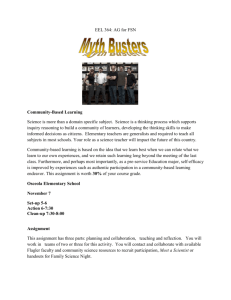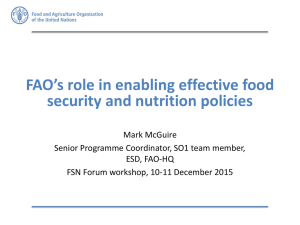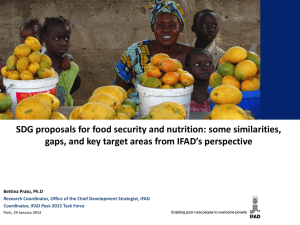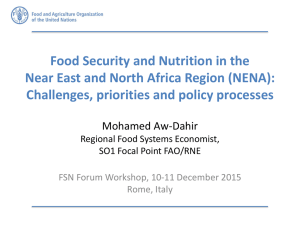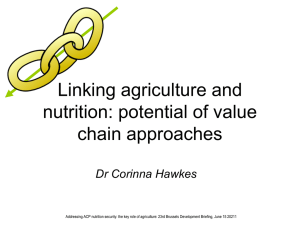Food Security Assessment in Cambodia
advertisement
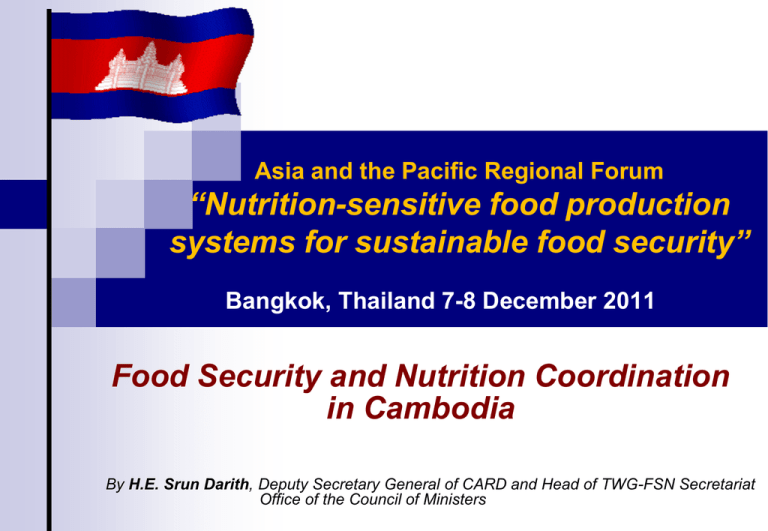
Asia and the Pacific Regional Forum “Nutrition-sensitive food production systems for sustainable food security” Bangkok, Thailand 7-8 December 2011 Food Security and Nutrition Coordination in Cambodia By H.E. Srun Darith, Deputy Secretary General of CARD and Head of TWG-FSN Secretariat Office of the Council of Ministers Background The Royal Government of Cambodia (RGC) is fully committed to ensuring “Right to Food” and achieving MDGs, in particular MDG1 RGC recognizes the extreme importance of FSN in addressing the country development priorities; RGC mandated the Council for Agricultural and Rural Development (CARD) to coordinate the cross-cutting issue of food security and nutrition (FSN) CARD as a coordinating body for FSN focuses it work on 4 areas: 1. Coordination and Networking 2. Policy support 3. Knowledge and Information management (KIM) 4. Monitoring and Evaluation 2 FSN-related Policies and Strategies Multi-sector The Rectangular Strategy for Growth, Employment, Equity and Efficiency Phase II is the framework for the country’s socioeconomic development. National Strategic Development Plan (NSDP) Update 20092013, the primary development policy document for Cambodia. Strategic Framework for Food Security and Nutrition in Cambodia 2008-2012 (SFFSN) developed based on the FSN Strategy Paper 2005. the review of the strategic framework has just been finishedand the update is planned in early 2012. The National Social Protection Strategy for the Poor and Vulnerable (NSPS) Food Security Support Programme under SAW 3 Agriculture sector The Strategy for Agriculture and Water 2010-2013 developed jointly by MAFF, WOWRAM and CARD with 5 programmes: 1. 2. 3. 4. 5. Institutional capacity building and management support programme Food security support programme (FSSP) Agricultural and agri-business support programme Water resources, irrigation management and land programme Agricultural and water resources research, education and extension programme Policy on the Promotion of Paddy Rice Production and Export of Milled Rice was developed and passed in 2010 4 Health sector The Health Strategic Plan II 2008-2015, the Ministry of Health’s primary policy document, follows the Health Sector Strategic Plan 2003–2007 and is complemented by the Cambodia Child Survival Strategy 2006-2015 National Nutrition Strategy 2009-2015 for interventions on improved nutrition Various National Guidelines on (1) Iron and Folic Acid Supplementation (2007), (2) Vitamin A Policy (1994, revised in 2001 and 2007), (3) Micronutrient Supplementation 5 FSN-related Programmes or Projects The MDG-F Joint Program for Children, Food Security and Nutrition in Cambodia a coordinated operation of 6 UN agencies and 6 government institutions HARVEST (Helping Address Rural Vulnerabilities and Ecosystem Stability) is a five year large food security initiative supported through USAID A proposal for GAFSP (Global Agriculture and Food Security Program) with the title “Reducing Global Risk and Vulnerability through improving Food Security and Household Nutrition in Cambodia” was approved Other large scale projects EFAP, EU-FF, WB), providing assistance to the poor and food insecure to cope with the impact of the crisis were designed 6 KMI for FSN a) FSN Capacity Building and Awareness Raising CARD initiated the establishment of a national trainer pool for FSN. The initiative was strongly supported by development partners and fully endorsed by the government. The National Trainer Pool, whose members are from the government, development partners, institutions, civil society and NGOs, was officially established in 2009, managed and coordinated by CARD. The main objective of the pool is to provide FSN training service on FSN. A number of trainings (including trainings contracted with several agencies, esp. FiA, UNESCO, HKI, WVC, CCC, LWF) have been conducted using the national trainer pool. 7 b) Food Security and Nutrition Information System (FSNIS) FSNIS (www.foodsecurity.gov.kh) was established by CARD In 2004 Used as a platform for information and knowledge sharing; a web portal for other FSN-related websites (SRI, Food Security Atlas, FIVIMS…); One of the most updated websites in Cambodia; Increasing numbers of users from diverse stakeholders according to thee user surveys conducted in 2005 and 2007 and in August 2011. 8 Monitoring and Evaluation An integrated food security and nutrition monitoring system has been established and managed by CARD in collaboration with concerned gov’t agencies & DPs. A Food Security and Nutrition Data Analysis Team (FSNDAT) was formed under the FSN Info Management Taskforce last year. The team, whose members are from most concerned government agencies namely CARD, NIS, MoH, MAFF, and MOWRAM, is responsible for the production of annual FSN monitoring reports and quarterly FSN bulletins by making analysis of available data and findings. 9 FSN Coordination and Networking Mechanism National Food Security Forum Created by CARD in 2003 and organized jointly with WFP & FAO; Members are representatives from government agencies, DPs, research institutions, and NGOs; An open forum for the exchange/sharing knowledge, information, and experiences with regard to FSN; Used as a platform to coordinate and jointly discuss problems/constraints related to FSN; So far 45 sessions of forum have been held 10 FSN Coordination and Networking Mechanism (Con’t) TWG-FSN Co-chaired by CARD & MoP, and facilitated by WFP; Created in 2005 as a joint Government-donor Working Group responsible for the coordination in FSN issues; Its members are representatives from relevant ministries, donor/UN agencies, and selected NGOs; FSN-Information Management Taskforce Co-chaired by CARD and NIS/MoP Established in late 2009 To coordinate different FSN-related information systems in Cambodia 11 Scale up action to improve nutrition? Updating the Strategic Framework for Food Security and Nutrition in 2012 is an opportunity to focus attention on making an intersectoral approach operational. Government and DPs are to put more efforts to address key barriers, such as feeding practices, maternal weight gain, and agricultural diversification. The review of the Health Strategic Plan, the Health Sector Support Project, and the SFFSN) all planned during 2nd half of 2011, will provide an opportunity to assess the impact of current nutrition interventions and to review priority actions More assistance in developing a national plan for scaling up nutrition is needed. Food fortification needs to be expanded, and more assistance for this effort is required. Existing Food Security and Nutrition M&E System needs to be strngthened. 12 Major Challenges and constraints Coordination and cooperation among FSN stakeholders are not yet satisfactory; FSN issues are insufficiently integrated in national and sub-national planning process due to limited knowledge and understanding of policy makers and planners. Active participation of key players is still limited. Some DPs ignore the coordinating structures, resulting in doubling of efforts, high transaction costs for RGC and low sustainability. Some DPs have their own agenda, and therefore programmes or projects funded by them are not aligned with the government’s policies and strategies. 13 Lessons learnt It’s good to have multi-disciplinary coordination structures for FSN which consist of government agencies, DPs and NGOs. Engage all relevant stakeholders in any process from the very beginning. Active participation of key actors is the key to success. Communications and advocacy are needed for FSN coordination. Competence, trust, and responsiveness are importance for successful coordination. 14 Many thanks for your kind attention. 15
